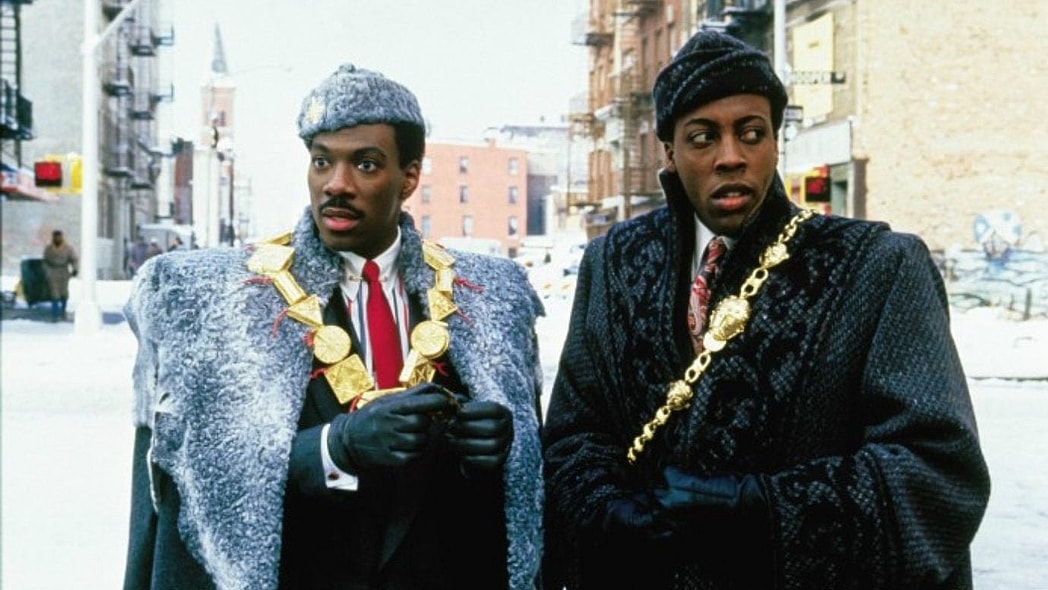Thirty years ago, when Coming to America was released, most of the white critics didn’t like it. “In making Coming to America, Murphy seems to have set his sights on the lowest prize imaginable. He aspires to blandness,” Washington Post staff writer Hal Hinson wrote in his review. Coming to America is a whole lot of things but bland is certainly not one of them. For so many of us, Eddie Murphy’s Prince Akeem and his friend/personal aide Semmi, played by Arsenio Hall, Murphy’s real-life best friend, show that, even when we as Black people try to downplay our greatness, we just can’t. Somehow that Zamunda just stays in us.
The groundbreaking TV mini-series, Roots, may have showed us all that Black Americans had African roots that we should never deny, but Coming to America, though a comedy, gave us permission to celebrate those roots. What seems like pure folly on the surface digs much deeper. Those glimpses of Zamunda, be it the pageantry of the royal court or the flower-dropping spectacle of Akeem’s mere presence, are just too powerful to shake. Yes Coming to America is a fairytale. A lot of it is a Cinderella story where the future king, in this instance an African one, finds his queen in Lisa McDowell (Shari Headley), a common Black American woman.
But it’s also a cultural fairytale. While Roots definitely prompted many Black Americans to retrace and reconnect with our African heritage, Coming to America actually excited us about Africa and doing so. Prince Akeem serves as a reminder, a wake-up call even, that there are things in us that are far greater than what we or other people regularly see.
Black Panther definitely seized upon that. It’s not a stretch to say Wakanda is an extension of Zamunda. With its largely US setting, Coming to America just gave us a taste of Zamunda. By placing Wakanda at its center, Black Panther served us a full course meal. At the end of Coming to America, we are left to imagine how wonderful life might be for Akeem and Lisa in Zamunda.
With Black Panther, we have a much better idea of just how Wakanda (and maybe Zamunda) works. We see the different tribes. We get a sense of its vast landscape. We peek inside its traditions. We even get to see some of its flaws. It’s a revelation. But is it one we will see outside of a Black Panther 2?
See Hollywood has a funny history when it comes to us. Even though Coming to America was a huge box office smash, ending as the year’s third highest grossing film and netting nearly $300 million (huge box office in 1988) overall, there were no follow-ups. Lawsuits, said Murphy during an interview on The Arsenio Hall Show reboot in 2013, killed a sequel on Paramount’s and his end.
“There was some dude who was claiming he was the prince. I be out in the club and this African dude would roll up on me and say, ‘I am the real prince! You stole my life from me! And I want my money! I’ll kill you!” he told Hall.
Those lawsuits, however, don’t explain why we had to wait 30 years later to see another big screen Black African-themed film. Isn’t it curious that, in a copycat town, no other studio even tried its hand at capitalizing on the $300 million magic of Coming to America? It’s popular to say that money makes the world go round. But Hollywood has a long history of ignoring dollars when it comes to representing us complexly. It seems awfully clear that Hollywood hasn’t been very interested in embracing and promoting positive depictions of Africa. With Black Panther grossing over a billion dollars, that absolutely should change.
Accepting the BET Awards trophy for Best Movie, Black Panther’s co-writer/director Ryan Coogler addressed Africa’s importance in the film and beyond. “In real talk the film is about our experiences being African Americans. Also trying to capture the experience of being African on this planet with so many factors telling you that it’s something you should be ashamed of, it’s something that you should hide, something that you should aspire to be something else. For us it was about tapping into that voice that we always hear that tell us to be proud of who we are and be proud of where we come from.”
Report: ‘Coming to America’ sequel is officially happening
Certainly there’s a sense of being “proud of who we are” and “where we come from” in Coming to America as well. And maybe that’s what kept Hollywood from flooding us with more Coming to Americas. Curiously, in a 2011 interview with Bomb Magazine, Coming to America’s white director John Landis, with whom Murphy worked on Trading Places, doesn’t seem to think much of the film Eddie Murphy conceived and takes credit for it not being a Black film.
“It was so successful; no one ever refers to that as an African American movie. Ever. Yet it has three speaking parts for white people. Every other speaking role is an African American,” Landis told Bomb.
Try telling us Coming to America isn’t a Black film. There is something so powerful about us and Africa on film our way that even transcends the doubt of those like Landis who worked in powerful positions on it. Is it unreasonable to conclude that the reason it took 30 years for Wakanda to follow Zamunda is because Hollywood doesn’t want us to see it? And Black Panther isn’t exactly a new idea in that it’s based on a comic book launched in 1966 by two white men. But maybe times are truly changing and Hollywood might be courting more Wakandas and Zamundas for the big screen. What’s absolutely certain, however, is 30 years later, Coming to America is as important as it has ever been.


